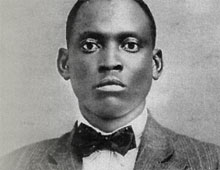[intro]Museums, the academy, galleries and biennales have historically played a major part in preserving the exotic allure that coddles the desires and fetishes of a white client base. To speak about African art is to inevitably wrestle with its unrelenting master signifiers; alterity, authenticity, the traditional and ‘the tribal’. Art Historian, ZAMANSELE NSELE sheds light on the historical patterns in visual art and its untiring push for ethnic signifiers, exoticism and the limits this has for work that is hailed as successful.[/intro]
At the heights of colonialism’s expanse, an Irish photographer, Alfred Martin Duggan-Cronin, travelled the continent. He toured across Southern Africa zig zagging from one native reserve to the next and he frequently travelled with a suitcase packed with ‘tribalesque’ trinkets in tow. Duggan-Cronin was known to request his sitters to switch their ‘western’ clothes for animal skins at a moment’s notice. This act was performed as a requirement for his famed ethnographic photo shoots.
Michael Godby, Professor of History of Art at the University of Cape Town, writes that the subjects of these images spoke back to the colonial photographer.
The nameless native questions the logic behind what seems a sudden reverse change of gear, symbolised by the sudden costume change. “Now you want to photograph us in our skins! The same skins you ridicule as uncivilised and barbaric!” The native must have thought this, in utter bemusement. Natives (in their skins) were cast as the very reversal of humankind and they were treated as such.
JM Coetzee comments on this aspect in White Writing, where he elaborates, “the people (the natives, the indigenous) generally may be thought to be men in the skins of beasts, or beasts created in the likeness and shape of men”. The tantalizing quality of contemporary African art is shaped by this original sin. It is precisely the seductive promise of the ethnographic ‘other’ that leaves its western clientele hungry for more. Fantasies of racial difference are peddled for consumption, ethnicity becomes a resource for pleasure. Bell Hooks calls this process “eating the other”.
The museum-circus-zoo triad and the reproduction of racial pleasure
To put things slightly differently, the language employed to understand objects (including people) of African origin, is embedded in a corrupt structure of reference. It is language founded historically on the institutional violence of namely museums in all their variations, including the circus and human zoos. It is an open secret that museums would commission grave robbers to unearth freshly buried bodies of indigenous Africans, namely the Khoisan for their collections, display and analysis (Legassick and Rassool 2000). Likewise, the museum, the circus, the human zoo (ethnological expositions) have played a crucial part in the racial enterprise, this fact is now often covered up and obscured “under a conspiracy of silence” (ibid). I would go as far as to say that the museum-circus-zoo triad represent the rudimentary beginnings of visual technologies that serve the reproduction of racial pleasure in the form of sadomasochistic enjoyment.
Think of the tragic voyage of the ‘impressionable’ young woman from the Gamtoos valley in the Eastern Cape, in 1810. I irk against simplifying Saartjie Baartman’s life to the soul shattering events that unfolded against her in Europe. Nonetheless, the same institutional triad exploits her body in spectacular ways. She is displayed at the Piccadilly Circus, then sold to an animal trainer (at some point she exhibited in a cage with a collar around her neck) and upon her death, her genitalia and bones are bottled and displayed in the museum of natural history for another 150 years.
At the level of aesthetic practice, her anatomy inspired what is arguably a watershed moment in modern expressionist painting, see Mattise’s ‘Blue Nude’ (Memory of Biskra). The prostitute trope in modern art is moulded from the anatomical form of a black woman; Baartman’s anatomical figure is centred as an object of desire and repulsion (Foster 1993). Then, similar, although obviously not in an identical visual register, let us think about the recent headline story of the pregnant woman from Suurfontein in the Eastern Cape, who was recently photographed sitting inside a sheep cage at the back of an Isuzu van. In a video that circulated on the aftermath of sheep cage photograph, Linda Steenkamp is recorded stammering that she deliberately chose to sit inside the sheep cage and not in the vacant seat in the front. Correspondingly, when Baartman was questioned in a British court about the whether she was exhibited (inside the cage) by her own consent, she likewise stated that she was not under restraint.
The coercive power sanctioned by institutions of art is just as nebulous. In a self-portrait by the artist Zanele Muholi, Somnyama Ngonyama (2015) she is photographed from the chest up, her head and shoulders are covered in dark grey sheepskin, leaving her face exposed, her dark and woolly figure dominates a pitch black drop. She stares into the camera, making visible the larger part of her scleras; the whites of her eyes. The image of Zanele Muholi, to a significant extent operates like Saartjie Baartman’s and Linda Steenkamp’s; they function within an equivalent visual cartography of enjoyment. Once again, by colonial design, we are positioned to visually participate in an unending cycle of sadomasochistic repetitions even through institutionally lauded mediums such as African art.











I see something genuinely interesting about your web blog so I saved to favorites.